List of Uralic languages
Uralic is a language family located in Northern Eurasia, in the countries of Finland, Estonia, Hungary (where Uralic languages are spoken by the majority of the population), in other countries Uralic languages are spoken by a minority of the population, these languages are spoken in far-northern Norway (in most of the Finnmark region and other regions of the far-north), in far-northern Sweden (in some areas of Norrland), and Russia (where Uralic languages are also spoken by a minority of its population, although there is a significant number of speakers in some Federal subjects - republics and autonomous districts or autonomous okrugs of Northern Russia, these languages are spoken in Udmurtia, Komi Republic, Mordvinia, Mari-El, Karelia, in Khanty-Mansi Autonomous Okrug, Yamal-Nenets Autonomous Okrug and Taymyr Autonomous Okrug and also in the former area of Komi-Permyak Autonomous Okrug, now part of the Perm Krai, other areas where Uralic languages are spoken in Russia are for example the Kola Peninsula). In Latvia, in some of the far-northern coastal areas of Courland (Kurzeme) region, an extinct Uralic language was spoken - Livonian.
Uralic languages are spoken by about 25 million people. Main Uralic languages in number of speakers are Hungarian (12-13 million), Finnish (5.4 million) and Estonian (1.1 million), that are also national and official languages of sovereign states.
.png.webp)
Hypothetical ancestors
Hypothetical relation to other language families and their proto-languages.
- Proto-Human (?)
- Several unknown language families and links (?)
- Borean/Boreal (?)
- Nostratic (?)
- Eurasiatic (?)
- Uralo-Siberian - Altaic (?)
- Uralo-Siberian (?)
- Indo-Uralic (?)
- Uralic-Yukaghir (?)
- Pre-Proto-Uralic (?)
- Uralic-Yukaghir (?)
- Indo-Uralic (?)
- Uralo-Siberian (?)
- Uralo-Siberian - Altaic (?)
- Eurasiatic (?)
- Nostratic (?)
- Borean/Boreal (?)
- Several unknown language families and links (?)
Ancestral
Samoyedic
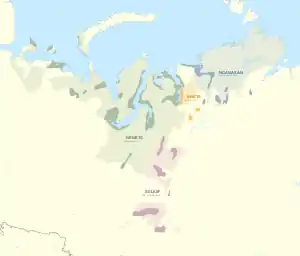
- Proto-Samoyedic (extinct)
- Nganasan (Tavgy, Tavgi, Tawgi, Tawgi-Samoyed) (Njaʔ / Ŋanasan Næ’)
- Avam
- Vadey
- Mator (Motor, Taigi, Karagas) (extinct)
- Mator proper / Motor
- Taygi
- Karagas
- Core Samoyedic
- Nenets-Enets
- Nenets (Yurak) (N’enytsia Wada / Nenyotsya’’ Wada)
- Transitional Nenets-Enets
- Yurats (extinct)
- Enets (Yenets, Yenisei-Samoyed)
- Selkup-Kamas
- Selkup (Ostyak-Samoyed) (Šöl’ Qumyt Əty)
- Kamassian (Kamas, Koibal) (formerly spoken by the Kamasins in the Sayan Mountains, South Central Siberia) (extinct)
- Nenets-Enets
- Nganasan (Tavgy, Tavgi, Tawgi, Tawgi-Samoyed) (Njaʔ / Ŋanasan Næ’)
Ob-Ugric
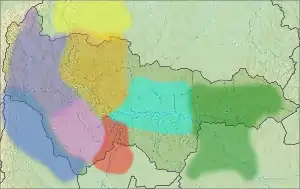

- Proto-Ob-Ugric (extinct)
- Mansi (Vogul) (Maan's’i Latyŋ) (a group of related languages, not a single language)
- Southern Mansi (Tavdin) (all extinct)
- Chusovaya (spoken in the western slopes of the Ural Mountains, to the east of Kama river, in the European side)
- Tagil
- Tura
- Tavda
- Core Mansi
- Central Mansi
- Western Mansi (all extinct)
- Vishera (spoken in the western slopes of the Ural Mountains, to the east of Kama river, in the European side)
- Pelym
- North Vagilsk
- South Vagilsk
- Lower Lozva
- Middle Lozva
- Eastern Mansi (Kondin)
- Lower Konda
- Middle Konda
- Upper Konda
- Jukonda
- Western Mansi (all extinct)
- Northern Mansi (base of the standard and literary Mansi language)
- Upper Lozva
- Sosva
- Sygva
- Ob
- Central Mansi
- Southern Mansi (Tavdin) (all extinct)
- Khanty (Ostyak) (Hantĭ jasaŋ / Khantõ Yasõŋ / Kantõk Yasõŋ) (a group of related languages, not a single language)
- Western Khanty
- Northern Khanty
- Obdorsk/Obdorian (Salekhard Khanty)
- Berjozov (Synja, Muzhi, Shurishkar), Kazym, Sherkal (Ob dialects)
- Transitional Northern-Southern Khanty
- Atlym-Nizyam Khanty
- Atlym
- Nizyam
- Atlym-Nizyam Khanty
- Southern Khanty (Irtysh Khanty) (all extinct)
- Upper Demjanka
- Lower Demjanka
- Konda
- Cingali
- Krasnojarsk
- Northern Khanty
- Transitional Western-Eastern Khanty
- Salym Khanty
- Eastern Khanty
- Surgut (Jugan, Malij Jugan, Pim, Likrisovskoe, Tremjugan, Tromagan)
- Far Eastern (Vakh, Vasjugan, Verkhne-Kalimsk, Vartovskoe)
- Western Khanty
- Mansi (Vogul) (Maan's’i Latyŋ) (a group of related languages, not a single language)
Magyar
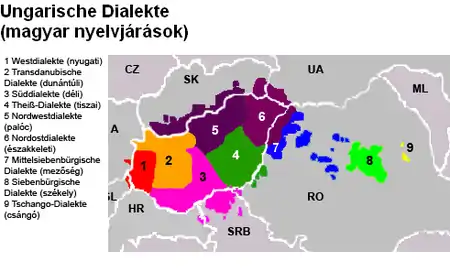
- Proto-Hungarian/Proto-Magyar (extinct)
- Old Hungarian (extinct)
- Hungarian (Magyar) (Magyar Nyelv)
- Northeast Hungary (Északkeleti)
- Palóc (Northwest) (Hungarian dialect with Cuman = Polovtsian, Khazar, Kabar and Pecheneg Turkic substrates, especially in Jász-Nagykun-Szolnok, in Jászság there is a Hungarian dialect with an Ossetian Sarmatian substrate of the Iranian branch of Indo-European)
- Tisza–Körös (Tiszai)
- Southern Great Plain
- Southern Transdanubian
- Central Transdanubian – Little Hungarian Plain
- Western Transdanubian
- Transylvanian Plain
- Székely (East Transylvanian)
- Csángó (West Moldavian Hungarian)
- Hungarian (Magyar) (Magyar Nyelv)
- Old Hungarian (extinct)
Permic (Bjarmian)
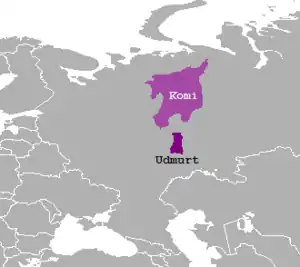
- Proto-Permic (extinct)
- Udmurt (Votyak) (Udmurt kyl)
- Southern Udmurt
- Northern Udmurt (spoken along Cheptsa River)
- Besermyan (spoken by the strongly Turkified Besermyans)
- Komi (Komi kyv / Komi kɨv) (a group of related languages, not a single language)
- Komi-Permyak (Perem Komi kɨv)
- Southern
- (/v/ type: вым /vɨm/, вӧв /vɘv/, вӧвтӧг /vɘvtɘg/, вӧвӧн /vɘvɘn/)
- Kudymkar-Inva
- Lower Inva
- Southern (/l/ type: лым /lɨm/, вӧл /vɘl/, вӧлтӧг /vɘltɘg/, вӧлӧн /vɘlɘn/)
- On
- Nerdva
- (/v/ type: вым /vɨm/, вӧв /vɘv/, вӧвтӧг /vɘvtɘg/, вӧвӧн /vɘvɘn/)
- Northern
- (/l/ type: лым /lɨm/ "snow", вӧл /vɘl/ "a horse", вӧлтӧг /vɘltɘg/ "without a horse", вӧлӧн /vɘlɘn/ "with a horse, on a horse")
- Upper Lupya
- Mysy (former rural council)
- Kosa-Kama
- Kochevo
- Zyuzdino (Afanasyevo)
- Yazva
- (/l/ type: лым /lɨm/ "snow", вӧл /vɘl/ "a horse", вӧлтӧг /vɘltɘg/ "without a horse", вӧлӧн /vɘlɘn/ "with a horse, on a horse")
- Southern
- Komi-Yodyak (Yodzyak, Komi-Jazva) (Komi-Yodz kyl)
- Komi-Zyryan (Komi, Komi-Zyrian, Zyrian) (basis of the standard and literary language) (Komi kyv / Komi kɨv)
- Prisyktyvkarsky
- Lower Vychegdan
- Central Vychegdan
- Luzsko-letsky
- Upper Sysolan
- Upper Vychegdan
- Pechoran
- Izhemsky
- Vymsky
- Udorsky
- Komi-Permyak (Perem Komi kɨv)
- Udmurt (Votyak) (Udmurt kyl)
Mari
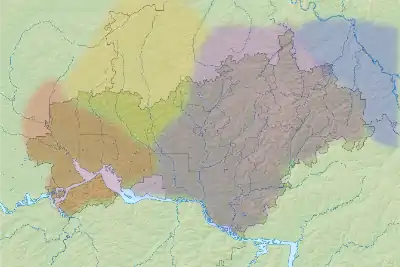
- Proto-Mari (extinct)
- Mari (Cheremis) (Marii jõlme) (a group of related languages, not a single language)
- Eastern-Meadow Mari
- Eastern Mari
- Meadow Mari (Olykmarla)
- Meadow Mari Proper
- Sernur-Morkin
- Volga
- Yoshkar-Olin
- Transitional Meadow Mari-Hill Mari
- Northwestern Mari (Jůtnṳ̊mäl-käsvel Mare jÿlmÿ)
- Yaransk dialect (the largest by number of speakers and spread territory, Northwestern Mari standardized variety)
- Kiknur subdialect
- Tuzha subdialect
- Sanchursk subdialect
- Tonshaevo dialect
- Lipsha dialect
- Sharanga dialect – the closest to Hill Mari
- Yaransk dialect (the largest by number of speakers and spread territory, Northwestern Mari standardized variety)
- Northwestern Mari (Jůtnṳ̊mäl-käsvel Mare jÿlmÿ)
- Hill Mari / Western Mari (Kyryk Mary jÿlmÿ)
- Kozymodemyan
- Yaran
- Eastern-Meadow Mari
- Mari (Cheremis) (Marii jõlme) (a group of related languages, not a single language)
Mordvinic
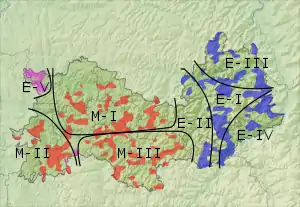
- Proto-Mordvinic (extinct)
- Erzya (Erzänj kelj)
- Central group (E-I)
- Western group (E-II)
- Northern group (E-III)
- Southeastern group (E-IV)
- Far Western group (E-V)
- Moksha (Mokšenj kälj)
- Central group (M-I)
- Western group (M-II)
- South-Eastern group (M-III)
- Erzya (Erzänj kelj)
Finnic
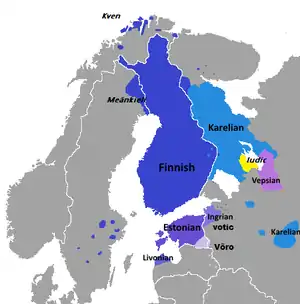
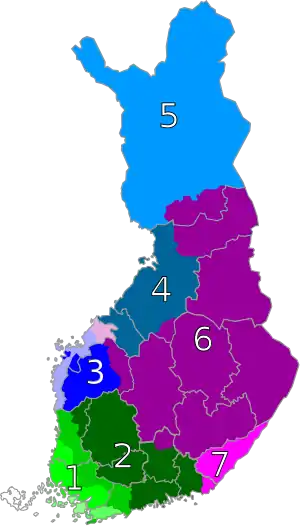
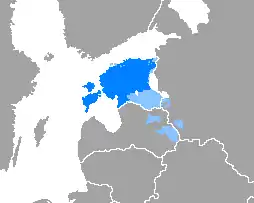
- Proto-Finnic (extinct)
- Inland Finnic
- Coastal Finnic
- Gulf of Riga Finnic
- Livonian (Līvõ kēļ / Raanda keel) (extinct)
- Courland Livonian (extinct) (revival attempts)
- Salaca Livonian (extinct)
- Livonian (Līvõ kēļ / Raanda keel) (extinct)
- Gulf of Finland Finnic
- Central Finnic
- Estonian (North Estonian) (Eesti keel)
- Central Estonian
- Eastern Estonian
- Insular Estonian
- Western Estonian (basis of Standard Estonian but not identical)
- Northeastern coastal Estonian (?) (Kirderannikumurre)
- Alutaguse dialect
- Coastal
- Votic (Vad’d’a tšeeli / Mā tšeeli / Vadyan cheeli / Vadyaa cheli) (nearly extinct)
- Eastern Votic (extinct)
- Western Votic
- Krevinian (extinct)
- Estonian (North Estonian) (Eesti keel)
- Northern Finnic
- Finnish (Suomi / Suomen kieli)
- Standard Finnish - Yleiskieli
- Colloquial Finnish - Puhekieli - spoken language
- Western dialects
- Southwestern dialects (Lounaismurteet)
- Southern dialect group
- Northern dialect group
- Southwestern transitional dialects
- Pori region dialects
- Ala-Satakunta dialects
- dialects of Turku highlands
- Somero region dialects
- Western Uusimaa dialects
- Tavastian dialects (Hämäläismurteet)
- Ylä-Satakunta dialects
- Heart Tavastian dialects
- Southern Tavastian dialects
- Southeastern Tavastian dialects
- Hollola dialect group
- Porvoo dialect group
- Iitti dialect group
- Southern Botnian (Ostrobothnian) dialects (Eteläpohjalaiset murteet)
- Middle and Northern Botnian (Ostrobothnian) dialects (Keski- ja Pohjoispohjalaiset murteet)
- Middle Botnian (Ostrobothnian) dialects
- Northern Botnian (Ostrobothnian) dialects
- Peräpohjola dialects (Peräpohjalaiset murteet) Far-Northern dialects
- Tornio dialects ("Meänkieli" in Sweden) (Tornedalian / Tornedalian Finnish)
- Kemi dialects
- Kemijärvi dialects
- Jällivaara dialects ("Meänkieli" in Sweden) (Tornedalian / Tornedalian Finnish)
- Ruija dialects ("Kven language" in Northern Norway) (Kven Finnish) (Kvääni / Kväänin kieli / Kainu / Kainun kieli)
- Southwestern dialects (Lounaismurteet)
- Eastern dialects
- Savonian dialects (Savolaismurteet)
- Northern Savonian dialects
- Southern Savonian dialects
- Middle dialects of Savonlinna region
- Eastern Savonian dialects or the dialects of North Karelia
- Kainuu dialects
- Central Finland dialects
- Päijänne Tavastia dialects
- Keuruu-Evijärvi dialects
- Savonian dialects of Värmland (Sweden) (once spoken by the Forest Finns - Metsäsuomalaiset)
- Southeastern dialects (Kaakkoismurteet) (Karelian Finnish) (Karjalaismurteet) (not to be confused with Karelian, a related but different language, although there is some dialect continuum between the two)
- Proper Southeastern dialects
- Middle dialects of Lemi region
- Dialects of Ingria (in Russia)
- Ingrian (Inkerin kieli / Ižoran kēli)
- Hevaha (extinct)
- Lower Luga
- Kukkozi dialect (?) (nearly extinct)
- Orodezhi (Upper Luga) (extinct)
- Soikkola dialect
- Savonian dialects (Savolaismurteet)
- Western dialects
- Karelian (Karjala / Kariela / Karjalan Kielii) (not to be confused with the Karelian dialect of Finnish although there is some dialect continuum between the two)
- Livvi (Olonets Karelian) (Livvi / Livvin kieli)
- Karelian proper (Karjala / Kariela / Karjalan Kielii)
- Northern Karelian (Viena)
- Southern Karelian
- Ludic (Lüüdi / Lüüdi kiel)
- Northern Ludic
- Central Ludic
- Kuuďärv Ludic
- Veps (Vepsän kelʹ / Vepsän keli / Vepsä / Veps kiel)
- Northern Veps (Onega Veps)
- Central Veps
- Southern Veps
- Finnish (Suomi / Suomen kieli)
- Central Finnic
- Gulf of Riga Finnic
Sami
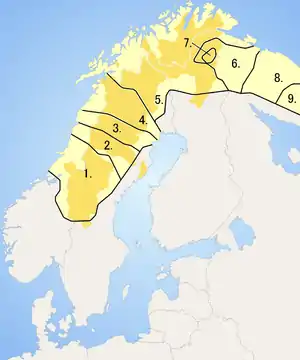
(Sami dialect continuum)
- Proto-Sami (extinct)
- Eastern Sami
- Mainland
- Inari Sami (Anarâškielâ)
- Kemi Sami (extinct) (Sáme giella)
- Skolt Sami (Sääʹmǩiõll / Nuõrttsääʹmǩiõll)
- Akkala Sami (extinct) (Sám kiöl)
- Kainuu Sami (extinct)
- Peninsular (Kola Sámi)
- Mainland
- Western Sami languages
- Northwestern
- Northern Sami (Davvisámegiella)
- Torne Sami
- Finnmark Sami
- Sea Sami
- Northwestern proper
- Lule Sami (Julevsámegiella)
- Northern dialects: Sörkaitum, Sirkas and Jåkkåkaska in Sweden, Tysfjord in Norway
- Southern dialects: Tuorpon in Sweden
- Forest dialects: Gällivare and Serri in Sweden
- Pite Sami (Bidumsámegiella)
- Northern dialects: Luokta-Mávas in Sweden
- Central dialects: Semisjaur-Njarg in Sweden
- Southern dialects: Svaipa in Sweden
- Lule Sami (Julevsámegiella)
- Northern Sami (Davvisámegiella)
- Southwestern
- Ume Sami (Ubmejesámiengiälla)
- Northwestern
- Southeastern
- Southern Sami (Åarjelsaemien gïele)
- Åsele dialect (Northern dialect)
- Jämtland dialect (Southern dialect)
- Ume Sami (Ubmejesámiengiälla)
- Northwestern
- Eastern Sami
Unclassified Uralic languages (all extinct)
Uralic languages whose relationship to other languages in the family is unclear
- Merya (spoken by the Merya, may have been a western branch of the Mari or close to the Mordvinic languages, may have been a transitional language between the Volga and the Baltic Finns)
- Meshcherian (spoken by the Meshchera, may have been related to the Mordvinic languages or to the Permic languages)
- Murom (spoken by the Muroma, may have been a language close to the Merya and a transitional language between the Volga and the Baltic Finns)
See also
References
- Abondolo, Daniel M. (editor). 1998. The Uralic Languages. London and New York: Routledge. ISBN 0-415-08198-X.
- Collinder, Björn. 1955. Fenno-Ugric Vocabulary: An Etymological Dictionary of the Uralic Languages. (Collective work.) Stockholm: Almqvist & Viksell. (Second, revised edition: Hamburg: Helmut Buske Verlag, 1977.)
- Collinder, Björn. 1957. Survey of the Uralic Languages. Stockholm.
- Collinder, Björn. 1960. Comparative Grammar of the Uralic Languages. Stockholm: Almqvist & Wiksell
- Comrie, Bernhard. 1988. "General Features of the Uralic Languages." In The Uralic Languages, edited by Denis Sinor, pp. 451–477. Leiden: Brill.
- Décsy, Gyula. 1990. The Uralic Protolanguage: A Comprehensive Reconstruction. Bloomington, Indiana.
- Hajdu, Péter. 1963. Finnugor népek és nyelvek. Budapest: Gondolat kiadó.
- Helimski, Eugene. Comparative Linguistics, Uralic Studies. Lectures and Articles. Moscow. 2000. (Russian: Хелимский Е.А. Компаративистика, уралистика. Лекции и статьи. М., 2000.)
- Laakso, Johanna. 1992. Uralilaiset kansat ('Uralic Peoples'). Porvoo – Helsinki – Juva. ISBN 951-0-16485-2.
- Korhonen, Mikko. 1986. Finno-Ugrian Language Studies in Finland 1828-1918. Helsinki: Societas Scientiarum Fennica. ISBN 951-653-135-0.
- Napolskikh, Vladimir. The First Stages of Origin of People of Uralic Language Family: Material of Mythological Reconstruction. Moscow, 1991. (Russian: Напольских В. В. Древнейшие этапы происхождения народов уральской языковой семьи: данные мифологической реконструкции. М., 1991.)
- Rédei, Károly (editor). 1986–88. Uralisches etymologisches Wörterbuch ('Uralic Etymological Dictionary'). Budapest.
- Wickman, Bo (1988). "The History of Uralic Languages". In Sinor, Denis (ed.). The Uralic Languages: Description, History, and Foreign Influences. Leiden: Brill. pp. 792–818. ISBN 978-90-04-07741-6. OCLC 16580570.CS1 maint: ref=harv (link)
External classification
- Sauvageot, Aurélien. 1930. Recherches sur le vocabulaire des langues ouralo-altaïques ('Research on the Vocabulary of the Uralo-Altaic Languages'). Paris.
Linguistic issues
- Künnap, A. 2000. Contact-induced Perspectives in Uralic Linguistics. LINCOM Studies in Asian Linguistics 39. München: LINCOM Europa. ISBN 3-89586-964-3.
- Wickman, Bo. 1955. The Form of the Object in the Uralic Languages. Uppsala: Lundequistska bokhandeln.
External links
| Wikimedia Commons has media related to Uralic languages. |
- "The Finno-Ugrics" The Economist, December 20, 2005
- Kulonen, Ulla-Maija: Origin of Finnish and related languages. thisisFINLAND, Finland Promotion Board. Cited 30.10.2009.